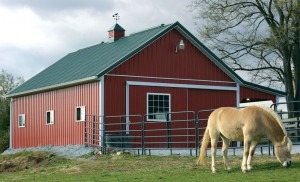Winter Horse Care: How Cold Is Too Cold?
 To keep your horse comfortable in its horse barn and healthy through the cold winter months, it’s important to try to forget what’s comfortable to you and consider what works for horses in the wild. While every horse has a different level of cold tolerance, and there are times when even the hardiest horse will need some extra shelter against the elements, your care regimen year-round should follow nature as much as possible.
To keep your horse comfortable in its horse barn and healthy through the cold winter months, it’s important to try to forget what’s comfortable to you and consider what works for horses in the wild. While every horse has a different level of cold tolerance, and there are times when even the hardiest horse will need some extra shelter against the elements, your care regimen year-round should follow nature as much as possible.
The following are some best practices we’ve learned over our years as a leading custom horse barn builder that you can follow to ensure your horse’s health and comfort through the winter.
Develop a Healthy Coat in the Fall
The best winter coat for a horse is the one nature provides every year. A horse that is left outside for most of the day through the fall months will slowly develop a heavy coat that will see it through most winter weather comfortably. With a full winter coat, many horses can withstand temperatures below freezing. Horses that are kept clipped or blanketed for show purposes or other reasons will not have that protection and will need further measures to stay warm through the winter.
Keep a Warm House and a Cold Barn
Keep your house nice and snug by all means—your hair won’t ever grow thick enough to do you any good outside—but your horse’s home should ideally be no more than 10 degrees warmer than outside temperatures. By keeping your barn close to outside temperatures, you’ll help your stabled horses maintain healthy coats and prevent temperature shocks when they go outdoors or exercise heavily.
Feed the Furnace
As temperatures drop, your horse stays comfortable by burning extra calories. It’s critical that you add hay or other feed to compensate for the calories required to maintain body heat. The rule of thumb is that horses require 25 percent more intake during the coldest winter months.
Watch Wind, Rain, and Extreme Lows
While a horse’s coat is usually heavy enough to handle winter weather, outdoor horses must have access to a three-sided shelter at all times to protect against wind and rain. When temperatures drop very low, you may need to bring vulnerable horses into the barn even if they have access to a shed. Ideally your shed should provide ready forage at all times through very cold conditions.
Check, Check, and Check Again
Like people, horses vary in their tolerance for cold and heat. Old horses, sick horses, and those with naturally lighter coats will get cold before horses that are more robust or have thicker coats. The only way to be sure an individual horse is comfortable is by monitoring it individually. Horses that are losing body weight or shivering are too cold and should be brought inside. Because winter coats can hide weight loss, it’s important to feel the ribcage with your hands to ensure proper weight maintenance during winter months.
Keep the Water Flowing
One aspect of horse management that poses particular challenges in the winter is maintaining a supply of clean unfrozen water. It’s critical to check outside water sources several times a day to ensure that they are still available for your horses.
With proper planning, your horse can weather the winter months comfortably without a lot of extra care. If you’re ready to create a shed or barn to carry your horse comfortably through the seasons, Conestoga can help. Our experienced staff will help you design a structure that puts your horse’s health first.
Just getting started? Contact us today to learn more and speak with one of our designers.
